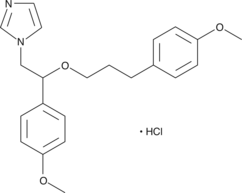Chemicals
Showing 35851–36000 of 41137 results
-
Sitaxentan is a potent nonpeptide endothelin A (ETA) receptor antagonist (IC50 = 1.4 nM).{52222} It is selective for ETA over ETB receptors (IC50 = 9,800 nM). Sitaxentan inhibits phosphoinositol hydrolysis induced by endothelin-1 (Item No. 24127) in COS-7 cells (pA2 = 8). In vivo, sitaxentan reduces blood pressure in a rat model of acute hypoxia-induced pulmonary hypertension (ED50 = 0.5 mg/kg). It reduces femoral artery neointimal lesion size in a mouse model of intraluminal injury.{52223} Sitaxentan (15 mg/kg) decreases bronchoalveolar lavage fluid (BALF) pleocytosis, as well as pulmonary collagen deposition and fibrosis, and improves lung mechanics in a mouse model of bleomycin-induced lung injury.{52224} Formulations containing sitaxentan have been used in the treatment of hypertension.
Brand:CaymanSKU:29244 - 100 mgAvailable on backorder
Sitaxentan is a potent nonpeptide endothelin A (ETA) receptor antagonist (IC50 = 1.4 nM).{52222} It is selective for ETA over ETB receptors (IC50 = 9,800 nM). Sitaxentan inhibits phosphoinositol hydrolysis induced by endothelin-1 (Item No. 24127) in COS-7 cells (pA2 = 8). In vivo, sitaxentan reduces blood pressure in a rat model of acute hypoxia-induced pulmonary hypertension (ED50 = 0.5 mg/kg). It reduces femoral artery neointimal lesion size in a mouse model of intraluminal injury.{52223} Sitaxentan (15 mg/kg) decreases bronchoalveolar lavage fluid (BALF) pleocytosis, as well as pulmonary collagen deposition and fibrosis, and improves lung mechanics in a mouse model of bleomycin-induced lung injury.{52224} Formulations containing sitaxentan have been used in the treatment of hypertension.
Brand:CaymanSKU:29244 - 25 mgAvailable on backorder
Sitaxentan is a potent nonpeptide endothelin A (ETA) receptor antagonist (IC50 = 1.4 nM).{52222} It is selective for ETA over ETB receptors (IC50 = 9,800 nM). Sitaxentan inhibits phosphoinositol hydrolysis induced by endothelin-1 (Item No. 24127) in COS-7 cells (pA2 = 8). In vivo, sitaxentan reduces blood pressure in a rat model of acute hypoxia-induced pulmonary hypertension (ED50 = 0.5 mg/kg). It reduces femoral artery neointimal lesion size in a mouse model of intraluminal injury.{52223} Sitaxentan (15 mg/kg) decreases bronchoalveolar lavage fluid (BALF) pleocytosis, as well as pulmonary collagen deposition and fibrosis, and improves lung mechanics in a mouse model of bleomycin-induced lung injury.{52224} Formulations containing sitaxentan have been used in the treatment of hypertension.
Brand:CaymanSKU:29244 - 5 mgAvailable on backorder
Sitostanol is a saturated sterol found in a variety of plants, including corn, wheat, and rice.{37799} It reduces cholesterol uptake in isolated rat jejunal loops when used at a concentration of 0.3 mM in a micellar solution containing cholesterol.{48000} Sitostanol decreases liver cholesterol levels and prevents abdominal aorta atheroma in rabbits when administered in a cholesterol-containing diet at 0.5%.{48001}
Brand:CaymanSKU:26094 - 1 mgAvailable on backorder
Sitostanol is a saturated sterol found in a variety of plants, including corn, wheat, and rice.{37799} It reduces cholesterol uptake in isolated rat jejunal loops when used at a concentration of 0.3 mM in a micellar solution containing cholesterol.{48000} Sitostanol decreases liver cholesterol levels and prevents abdominal aorta atheroma in rabbits when administered in a cholesterol-containing diet at 0.5%.{48001}
Brand:CaymanSKU:26094 - 10 mgAvailable on backorder
Sitostanol is a saturated sterol found in a variety of plants, including corn, wheat, and rice.{37799} It reduces cholesterol uptake in isolated rat jejunal loops when used at a concentration of 0.3 mM in a micellar solution containing cholesterol.{48000} Sitostanol decreases liver cholesterol levels and prevents abdominal aorta atheroma in rabbits when administered in a cholesterol-containing diet at 0.5%.{48001}
Brand:CaymanSKU:26094 - 25 mgAvailable on backorder
Sitostanol is a saturated sterol found in a variety of plants, including corn, wheat, and rice.{37799} It reduces cholesterol uptake in isolated rat jejunal loops when used at a concentration of 0.3 mM in a micellar solution containing cholesterol.{48000} Sitostanol decreases liver cholesterol levels and prevents abdominal aorta atheroma in rabbits when administered in a cholesterol-containing diet at 0.5%.{48001}
Brand:CaymanSKU:26094 - 5 mgAvailable on backorder
Sitravatinib is a multi-kinase inhibitor.{53144} It inhibits 35 kinases (IC50s = 0.5-5,550 nM) in a panel of 55 receptor tyrosine kinases (RTKs). Sitravatinib reduces proliferation of A-673, LPS141, MPNST, DDLS, and Saos-2 cancer cells (IC50s = 1,750, 340.1, 705.7, 266, and 1,830 nM, respectively) and decreases phosphorylation of insulin-like growth factor 1 receptor (IGF1-R), PDGFRβ, and Akt in these same cells when used at concentrations ranging from 62.5 to 4,000 nM. It decreases tumor growth in LPS141 and MPNST mouse xenograft models when administered at a dose of 15 mg/kg per day.
Brand:CaymanSKU:27338 - 10 mgAvailable on backorder
Sitravatinib is a multi-kinase inhibitor.{53144} It inhibits 35 kinases (IC50s = 0.5-5,550 nM) in a panel of 55 receptor tyrosine kinases (RTKs). Sitravatinib reduces proliferation of A-673, LPS141, MPNST, DDLS, and Saos-2 cancer cells (IC50s = 1,750, 340.1, 705.7, 266, and 1,830 nM, respectively) and decreases phosphorylation of insulin-like growth factor 1 receptor (IGF1-R), PDGFRβ, and Akt in these same cells when used at concentrations ranging from 62.5 to 4,000 nM. It decreases tumor growth in LPS141 and MPNST mouse xenograft models when administered at a dose of 15 mg/kg per day.
Brand:CaymanSKU:27338 - 25 mgAvailable on backorder
Sitravatinib is a multi-kinase inhibitor.{53144} It inhibits 35 kinases (IC50s = 0.5-5,550 nM) in a panel of 55 receptor tyrosine kinases (RTKs). Sitravatinib reduces proliferation of A-673, LPS141, MPNST, DDLS, and Saos-2 cancer cells (IC50s = 1,750, 340.1, 705.7, 266, and 1,830 nM, respectively) and decreases phosphorylation of insulin-like growth factor 1 receptor (IGF1-R), PDGFRβ, and Akt in these same cells when used at concentrations ranging from 62.5 to 4,000 nM. It decreases tumor growth in LPS141 and MPNST mouse xenograft models when administered at a dose of 15 mg/kg per day.
Brand:CaymanSKU:27338 - 5 mgAvailable on backorder
Sitravatinib is a multi-kinase inhibitor.{53144} It inhibits 35 kinases (IC50s = 0.5-5,550 nM) in a panel of 55 receptor tyrosine kinases (RTKs). Sitravatinib reduces proliferation of A-673, LPS141, MPNST, DDLS, and Saos-2 cancer cells (IC50s = 1,750, 340.1, 705.7, 266, and 1,830 nM, respectively) and decreases phosphorylation of insulin-like growth factor 1 receptor (IGF1-R), PDGFRβ, and Akt in these same cells when used at concentrations ranging from 62.5 to 4,000 nM. It decreases tumor growth in LPS141 and MPNST mouse xenograft models when administered at a dose of 15 mg/kg per day.
Brand:CaymanSKU:27338 - 50 mgAvailable on backorder
Sivelestat is a potent and selective inhibitor of neutrophil elastase (IC50 = 44 nM).{29354} It is without effect on a panel of related proteases.{29354} Sivelestat is effective in vivo, blocking elastase-dependent acute lung injury induced by intratracheal administration of LPS.{29354,29356} Elastase inhibitors, including sivelestat, have clinical utility in protecting against direct or indirect lung injury, with or without concomitant sepsis.{29353,29355,23600}
Brand:CaymanSKU:-Available on backorder
Sivelestat is a potent and selective inhibitor of neutrophil elastase (IC50 = 44 nM).{29354} It is without effect on a panel of related proteases.{29354} Sivelestat is effective in vivo, blocking elastase-dependent acute lung injury induced by intratracheal administration of LPS.{29354,29356} Elastase inhibitors, including sivelestat, have clinical utility in protecting against direct or indirect lung injury, with or without concomitant sepsis.{29353,29355,23600}
Brand:CaymanSKU:-Available on backorder
Sivelestat is a potent and selective inhibitor of neutrophil elastase (IC50 = 44 nM).{29354} It is without effect on a panel of related proteases.{29354} Sivelestat is effective in vivo, blocking elastase-dependent acute lung injury induced by intratracheal administration of LPS.{29354,29356} Elastase inhibitors, including sivelestat, have clinical utility in protecting against direct or indirect lung injury, with or without concomitant sepsis.{29353,29355,23600}
Brand:CaymanSKU:-Available on backorder
Sivelestat is a potent and selective inhibitor of neutrophil elastase (IC50 = 44 nM).{29354} It is without effect on a panel of related proteases.{29354} Sivelestat is effective in vivo, blocking elastase-dependent acute lung injury induced by intratracheal administration of LPS.{29354,29356} Elastase inhibitors, including sivelestat, have clinical utility in protecting against direct or indirect lung injury, with or without concomitant sepsis.{29353,29355,23600}
Brand:CaymanSKU:-Available on backorder
SJ 172550 is an inhibitor of MDMX that disrupts MDMX-p53 peptide interaction with an EC50 value of 4.3 µM.{33300} It forms a covalent, but reversible, cysteine adduct in the MDMX p53-binding domain, locking MDMX into a conformation that prevents binding to p53.{33301} SJ 172550 induces apoptosis, increases p53 target gene expression, and causes p53-dependent cell death in retinoblastoma cells.{33300}
Brand:CaymanSKU:19999 -Available on backorder
SJ 172550 is an inhibitor of MDMX that disrupts MDMX-p53 peptide interaction with an EC50 value of 4.3 µM.{33300} It forms a covalent, but reversible, cysteine adduct in the MDMX p53-binding domain, locking MDMX into a conformation that prevents binding to p53.{33301} SJ 172550 induces apoptosis, increases p53 target gene expression, and causes p53-dependent cell death in retinoblastoma cells.{33300}
Brand:CaymanSKU:19999 -Available on backorder
SJ 172550 is an inhibitor of MDMX that disrupts MDMX-p53 peptide interaction with an EC50 value of 4.3 µM.{33300} It forms a covalent, but reversible, cysteine adduct in the MDMX p53-binding domain, locking MDMX into a conformation that prevents binding to p53.{33301} SJ 172550 induces apoptosis, increases p53 target gene expression, and causes p53-dependent cell death in retinoblastoma cells.{33300}
Brand:CaymanSKU:19999 -Available on backorder
SJ000291942 is a bone morphogenic protein (BMP) signaling activator.{52365} It activates BMP4 in C33A-2D2 human cervical carcinoma clonal reporter cells (EC50 = ≤1 µM). SJ000291942 (0.1-50 µM) induces ventralization, as well as increases expression of the BMP target genes bmp2b and szl and the cooperatively-induced BMP target genes vent and vox in zebrafish embryos. It also induces BMP-dependent osteoblastic differentiation of C2C12 murine myoblasts.
Brand:CaymanSKU:29904 - 10 mgAvailable on backorder
SJ000291942 is a bone morphogenic protein (BMP) signaling activator.{52365} It activates BMP4 in C33A-2D2 human cervical carcinoma clonal reporter cells (EC50 = ≤1 µM). SJ000291942 (0.1-50 µM) induces ventralization, as well as increases expression of the BMP target genes bmp2b and szl and the cooperatively-induced BMP target genes vent and vox in zebrafish embryos. It also induces BMP-dependent osteoblastic differentiation of C2C12 murine myoblasts.
Brand:CaymanSKU:29904 - 25 mgAvailable on backorder
SJ000291942 is a bone morphogenic protein (BMP) signaling activator.{52365} It activates BMP4 in C33A-2D2 human cervical carcinoma clonal reporter cells (EC50 = ≤1 µM). SJ000291942 (0.1-50 µM) induces ventralization, as well as increases expression of the BMP target genes bmp2b and szl and the cooperatively-induced BMP target genes vent and vox in zebrafish embryos. It also induces BMP-dependent osteoblastic differentiation of C2C12 murine myoblasts.
Brand:CaymanSKU:29904 - 5 mgAvailable on backorder
SKA-121 is a positive-gating modulator of intermediate-conductance calcium-activated potassium channels (IKCa1/KCa3.1) with an EC50 value of 109 nM using whole-cell patch-clamp electrophysiology with calcium in the internal solution.{41411} It is selective for KCa3.1 over KCa2.1, KCa2.2 and KCa2.3 (EC50s = 8,700, 6,800, and 4,400 nM, respectively).{41410} It is also selective over KCa1.1 as well as voltage-gated potassium and sodium channels. SKA-121 (1 µM) potentiates calcium-evoked KCa currents by approximately 7-fold using whole-cell patch-clamp electrophysiology, an effect that can be blocked by the KCa3.1 inhibitor TRAM-34 (Item No. 23385).{41411} It also potentiates calcium-evoked and basal KCa currents. In large porcine coronary arteries ex vivo, SKA-121 potentiates bradykinin-induced endothelium-dependent relaxation (EC50 = 7.9 nM). It also lowers mean arterial blood pressure (MAP) by approximately 20 and 25 mm Hg in normo- and hypertensive mice when used at a dose of 100 mg/kg but has no effect on MAP in KCa3.1 knockout mice.{41410}
Brand:CaymanSKU:9003088 - 1 mgAvailable on backorder
SKA-121 is a positive-gating modulator of intermediate-conductance calcium-activated potassium channels (IKCa1/KCa3.1) with an EC50 value of 109 nM using whole-cell patch-clamp electrophysiology with calcium in the internal solution.{41411} It is selective for KCa3.1 over KCa2.1, KCa2.2 and KCa2.3 (EC50s = 8,700, 6,800, and 4,400 nM, respectively).{41410} It is also selective over KCa1.1 as well as voltage-gated potassium and sodium channels. SKA-121 (1 µM) potentiates calcium-evoked KCa currents by approximately 7-fold using whole-cell patch-clamp electrophysiology, an effect that can be blocked by the KCa3.1 inhibitor TRAM-34 (Item No. 23385).{41411} It also potentiates calcium-evoked and basal KCa currents. In large porcine coronary arteries ex vivo, SKA-121 potentiates bradykinin-induced endothelium-dependent relaxation (EC50 = 7.9 nM). It also lowers mean arterial blood pressure (MAP) by approximately 20 and 25 mm Hg in normo- and hypertensive mice when used at a dose of 100 mg/kg but has no effect on MAP in KCa3.1 knockout mice.{41410}
Brand:CaymanSKU:9003088 - 10 mgAvailable on backorder
SKA-121 is a positive-gating modulator of intermediate-conductance calcium-activated potassium channels (IKCa1/KCa3.1) with an EC50 value of 109 nM using whole-cell patch-clamp electrophysiology with calcium in the internal solution.{41411} It is selective for KCa3.1 over KCa2.1, KCa2.2 and KCa2.3 (EC50s = 8,700, 6,800, and 4,400 nM, respectively).{41410} It is also selective over KCa1.1 as well as voltage-gated potassium and sodium channels. SKA-121 (1 µM) potentiates calcium-evoked KCa currents by approximately 7-fold using whole-cell patch-clamp electrophysiology, an effect that can be blocked by the KCa3.1 inhibitor TRAM-34 (Item No. 23385).{41411} It also potentiates calcium-evoked and basal KCa currents. In large porcine coronary arteries ex vivo, SKA-121 potentiates bradykinin-induced endothelium-dependent relaxation (EC50 = 7.9 nM). It also lowers mean arterial blood pressure (MAP) by approximately 20 and 25 mm Hg in normo- and hypertensive mice when used at a dose of 100 mg/kg but has no effect on MAP in KCa3.1 knockout mice.{41410}
Brand:CaymanSKU:9003088 - 5 mgAvailable on backorder
SKA-121 is a positive-gating modulator of intermediate-conductance calcium-activated potassium channels (IKCa1/KCa3.1) with an EC50 value of 109 nM using whole-cell patch-clamp electrophysiology with calcium in the internal solution.{41411} It is selective for KCa3.1 over KCa2.1, KCa2.2 and KCa2.3 (EC50s = 8,700, 6,800, and 4,400 nM, respectively).{41410} It is also selective over KCa1.1 as well as voltage-gated potassium and sodium channels. SKA-121 (1 µM) potentiates calcium-evoked KCa currents by approximately 7-fold using whole-cell patch-clamp electrophysiology, an effect that can be blocked by the KCa3.1 inhibitor TRAM-34 (Item No. 23385).{41411} It also potentiates calcium-evoked and basal KCa currents. In large porcine coronary arteries ex vivo, SKA-121 potentiates bradykinin-induced endothelium-dependent relaxation (EC50 = 7.9 nM). It also lowers mean arterial blood pressure (MAP) by approximately 20 and 25 mm Hg in normo- and hypertensive mice when used at a dose of 100 mg/kg but has no effect on MAP in KCa3.1 knockout mice.{41410}
Brand:CaymanSKU:9003088 - 500 µgAvailable on backorder
SKA-31 is an activator of the small- and intermediate conductance calcium-activated potassium channels KCa2.1, KCa2.2, KCa2.3, and KCa3.1 (EC50s = 2.9, 1.9, 2.9, and 0.26 µM, respectively, in a patch-clamp assay).{52233} It also blocks the voltage-gated potassium (Kv) channels Kv1.3, Kv1.5, Kv3.1, and Kv3.2 by 10 to 30% and the voltage-gated sodium (Nav) channels Nav1.2, Nav1.4, and Nav1.5 by 9 to 40% in a panel of 13 ion channels when used at a concentration of 25 µM. SKA-31 increases vasodilation induced by acetylcholine (Item No. 23829) in isolated mouse carotid artery (EC50 = 93 nM) and induces relaxation of isolated rat mesenteric artery rings precontracted with phenylephrine (IC50 = 93 nM).{52233,52234} It decreases blood pressure in normotensive and angiotensin II-induced hypertensive mice when administered at a dose of 30 mg/kg.{52233}
Brand:CaymanSKU:29690 - 10 mgAvailable on backorder
SKA-31 is an activator of the small- and intermediate conductance calcium-activated potassium channels KCa2.1, KCa2.2, KCa2.3, and KCa3.1 (EC50s = 2.9, 1.9, 2.9, and 0.26 µM, respectively, in a patch-clamp assay).{52233} It also blocks the voltage-gated potassium (Kv) channels Kv1.3, Kv1.5, Kv3.1, and Kv3.2 by 10 to 30% and the voltage-gated sodium (Nav) channels Nav1.2, Nav1.4, and Nav1.5 by 9 to 40% in a panel of 13 ion channels when used at a concentration of 25 µM. SKA-31 increases vasodilation induced by acetylcholine (Item No. 23829) in isolated mouse carotid artery (EC50 = 93 nM) and induces relaxation of isolated rat mesenteric artery rings precontracted with phenylephrine (IC50 = 93 nM).{52233,52234} It decreases blood pressure in normotensive and angiotensin II-induced hypertensive mice when administered at a dose of 30 mg/kg.{52233}
Brand:CaymanSKU:29690 - 25 mgAvailable on backorder
SKA-31 is an activator of the small- and intermediate conductance calcium-activated potassium channels KCa2.1, KCa2.2, KCa2.3, and KCa3.1 (EC50s = 2.9, 1.9, 2.9, and 0.26 µM, respectively, in a patch-clamp assay).{52233} It also blocks the voltage-gated potassium (Kv) channels Kv1.3, Kv1.5, Kv3.1, and Kv3.2 by 10 to 30% and the voltage-gated sodium (Nav) channels Nav1.2, Nav1.4, and Nav1.5 by 9 to 40% in a panel of 13 ion channels when used at a concentration of 25 µM. SKA-31 increases vasodilation induced by acetylcholine (Item No. 23829) in isolated mouse carotid artery (EC50 = 93 nM) and induces relaxation of isolated rat mesenteric artery rings precontracted with phenylephrine (IC50 = 93 nM).{52233,52234} It decreases blood pressure in normotensive and angiotensin II-induced hypertensive mice when administered at a dose of 30 mg/kg.{52233}
Brand:CaymanSKU:29690 - 5 mgAvailable on backorder
SKA-31 is an activator of the small- and intermediate conductance calcium-activated potassium channels KCa2.1, KCa2.2, KCa2.3, and KCa3.1 (EC50s = 2.9, 1.9, 2.9, and 0.26 µM, respectively, in a patch-clamp assay).{52233} It also blocks the voltage-gated potassium (Kv) channels Kv1.3, Kv1.5, Kv3.1, and Kv3.2 by 10 to 30% and the voltage-gated sodium (Nav) channels Nav1.2, Nav1.4, and Nav1.5 by 9 to 40% in a panel of 13 ion channels when used at a concentration of 25 µM. SKA-31 increases vasodilation induced by acetylcholine (Item No. 23829) in isolated mouse carotid artery (EC50 = 93 nM) and induces relaxation of isolated rat mesenteric artery rings precontracted with phenylephrine (IC50 = 93 nM).{52233,52234} It decreases blood pressure in normotensive and angiotensin II-induced hypertensive mice when administered at a dose of 30 mg/kg.{52233}
Brand:CaymanSKU:29690 - 50 mgAvailable on backorder
Skepinone-L is an ATP-competitive inhibitor of p38 MAPK isoform p38α (IC50s = 5 nM) and p38β (97% inhibition at 1 µM).{26162,26163} It has little effect on a range of other kinases, including p38γ and p38δ. Skepinone-L dose-dependently blocks the phosphorylation of heat shock protein 27 (HSP27), a p38 MAPK substrate, in response to stimulation with anisomycin (Item No. 11308) in HeLa cells (IC50 = 25 nM) or TNF-α in THP-1 cells.{26162,26163} At 1 µM, it prevents phosphorylation of cytosolic phospholipase A2 in platelets in response to collagen-related peptide or thrombin (Item No. 13188), blunting platelet secretion and aggregation.{26164}
Brand:CaymanSKU:-Out of stock
Skepinone-L is an ATP-competitive inhibitor of p38 MAPK isoform p38α (IC50s = 5 nM) and p38β (97% inhibition at 1 µM).{26162,26163} It has little effect on a range of other kinases, including p38γ and p38δ. Skepinone-L dose-dependently blocks the phosphorylation of heat shock protein 27 (HSP27), a p38 MAPK substrate, in response to stimulation with anisomycin (Item No. 11308) in HeLa cells (IC50 = 25 nM) or TNF-α in THP-1 cells.{26162,26163} At 1 µM, it prevents phosphorylation of cytosolic phospholipase A2 in platelets in response to collagen-related peptide or thrombin (Item No. 13188), blunting platelet secretion and aggregation.{26164}
Brand:CaymanSKU:-Out of stock
Skepinone-L is an ATP-competitive inhibitor of p38 MAPK isoform p38α (IC50s = 5 nM) and p38β (97% inhibition at 1 µM).{26162,26163} It has little effect on a range of other kinases, including p38γ and p38δ. Skepinone-L dose-dependently blocks the phosphorylation of heat shock protein 27 (HSP27), a p38 MAPK substrate, in response to stimulation with anisomycin (Item No. 11308) in HeLa cells (IC50 = 25 nM) or TNF-α in THP-1 cells.{26162,26163} At 1 µM, it prevents phosphorylation of cytosolic phospholipase A2 in platelets in response to collagen-related peptide or thrombin (Item No. 13188), blunting platelet secretion and aggregation.{26164}
Brand:CaymanSKU:-Out of stock
Skepinone-L is an ATP-competitive inhibitor of p38 MAPK isoform p38α (IC50s = 5 nM) and p38β (97% inhibition at 1 µM).{26162,26163} It has little effect on a range of other kinases, including p38γ and p38δ. Skepinone-L dose-dependently blocks the phosphorylation of heat shock protein 27 (HSP27), a p38 MAPK substrate, in response to stimulation with anisomycin (Item No. 11308) in HeLa cells (IC50 = 25 nM) or TNF-α in THP-1 cells.{26162,26163} At 1 µM, it prevents phosphorylation of cytosolic phospholipase A2 in platelets in response to collagen-related peptide or thrombin (Item No. 13188), blunting platelet secretion and aggregation.{26164}
Brand:CaymanSKU:-Out of stock
SKF 38393 is a partial agonist of the dopamine D1-like receptors D1 and D5 (Kis = 1 and ~0.5 nM, respectively).{32473} It less potently binds D2, D3, and D4 receptors (Kis = ~150, 5,000, and 1,000 nM, respectively).{23473,24103}
Brand:CaymanSKU:-Available on backorder
SKF 38393 is a partial agonist of the dopamine D1-like receptors D1 and D5 (Kis = 1 and ~0.5 nM, respectively).{32473} It less potently binds D2, D3, and D4 receptors (Kis = ~150, 5,000, and 1,000 nM, respectively).{23473,24103}
Brand:CaymanSKU:-Available on backorder
SKF 38393 is a partial agonist of the dopamine D1-like receptors D1 and D5 (Kis = 1 and ~0.5 nM, respectively).{32473} It less potently binds D2, D3, and D4 receptors (Kis = ~150, 5,000, and 1,000 nM, respectively).{23473,24103}
Brand:CaymanSKU:-Available on backorder
SKF 38393 is a partial agonist of the dopamine D1-like receptors D1 and D5 (Kis = 1 and ~0.5 nM, respectively).{32473} It less potently binds D2, D3, and D4 receptors (Kis = ~150, 5,000, and 1,000 nM, respectively).{23473,24103}
Brand:CaymanSKU:-Available on backorder
SKF 525A is a widely used, nonspecific cytochrome P (CYP)450 inhibitor that demonstrates 100% inhibition of the various CYP450 isoforms at 1-100 μM.{24114} It therefore potentiates the effects of many different drugs by inhibiting their metabolism (IC50 values in the μM range when tested using human liver microsomes).{24115} SKF 525A inhibits CYP450-dependent arachidonic acid conversion to active EET metabolites, antagonizing the recovery of functional calcium pools.{5318} It also acts as a noncompetitive inhibitor of acetylcholine nicotinic receptors (IC50 = 19 μM in mouse skeletal muscle).{9025,24116}
Brand:CaymanSKU:-SKF 525A is a widely used, nonspecific cytochrome P (CYP)450 inhibitor that demonstrates 100% inhibition of the various CYP450 isoforms at 1-100 μM.{24114} It therefore potentiates the effects of many different drugs by inhibiting their metabolism (IC50 values in the μM range when tested using human liver microsomes).{24115} SKF 525A inhibits CYP450-dependent arachidonic acid conversion to active EET metabolites, antagonizing the recovery of functional calcium pools.{5318} It also acts as a noncompetitive inhibitor of acetylcholine nicotinic receptors (IC50 = 19 μM in mouse skeletal muscle).{9025,24116}
Brand:CaymanSKU:-SKF 525A is a widely used, nonspecific cytochrome P (CYP)450 inhibitor that demonstrates 100% inhibition of the various CYP450 isoforms at 1-100 μM.{24114} It therefore potentiates the effects of many different drugs by inhibiting their metabolism (IC50 values in the μM range when tested using human liver microsomes).{24115} SKF 525A inhibits CYP450-dependent arachidonic acid conversion to active EET metabolites, antagonizing the recovery of functional calcium pools.{5318} It also acts as a noncompetitive inhibitor of acetylcholine nicotinic receptors (IC50 = 19 μM in mouse skeletal muscle).{9025,24116}
Brand:CaymanSKU:-SKF 525A is a widely used, nonspecific cytochrome P (CYP)450 inhibitor that demonstrates 100% inhibition of the various CYP450 isoforms at 1-100 μM.{24114} It therefore potentiates the effects of many different drugs by inhibiting their metabolism (IC50 values in the μM range when tested using human liver microsomes).{24115} SKF 525A inhibits CYP450-dependent arachidonic acid conversion to active EET metabolites, antagonizing the recovery of functional calcium pools.{5318} It also acts as a noncompetitive inhibitor of acetylcholine nicotinic receptors (IC50 = 19 μM in mouse skeletal muscle).{9025,24116}
Brand:CaymanSKU:-SKF 82958 is a dopamine D1 receptor agonist (K0.5 = 4 nM in a radioligand binding assay).{45668} It is selective for dopamine D1 over D2 receptors (K0.5 = 73 nM). SKF 82958 induces dopamine D1 receptor-dependent adenylate cyclase activity in rat striatal membranes (EC50 = 491 nM). SKF 82958 (3 mg/kg) prevents and reverses fentanyl-induced respiratory depression, without affecting analgesia, in cats.{45669} It also increases locomotion and rearing in rats.{45670}
Brand:CaymanSKU:29033 - 10 mgAvailable on backorder
SKF 82958 is a dopamine D1 receptor agonist (K0.5 = 4 nM in a radioligand binding assay).{45668} It is selective for dopamine D1 over D2 receptors (K0.5 = 73 nM). SKF 82958 induces dopamine D1 receptor-dependent adenylate cyclase activity in rat striatal membranes (EC50 = 491 nM). SKF 82958 (3 mg/kg) prevents and reverses fentanyl-induced respiratory depression, without affecting analgesia, in cats.{45669} It also increases locomotion and rearing in rats.{45670}
Brand:CaymanSKU:29033 - 25 mgAvailable on backorder
SKF 82958 is a dopamine D1 receptor agonist (K0.5 = 4 nM in a radioligand binding assay).{45668} It is selective for dopamine D1 over D2 receptors (K0.5 = 73 nM). SKF 82958 induces dopamine D1 receptor-dependent adenylate cyclase activity in rat striatal membranes (EC50 = 491 nM). SKF 82958 (3 mg/kg) prevents and reverses fentanyl-induced respiratory depression, without affecting analgesia, in cats.{45669} It also increases locomotion and rearing in rats.{45670}
Brand:CaymanSKU:29033 - 5 mgAvailable on backorder
SKF 83566 is a dopamine D1 receptor antagonist.{48782,48783,48784} In vivo, SKF 83566 (0.005, 0.01, and 0.03 mg/kg) reduces dexbenzetimide- and scopolamine-induced locomotor stereotypy in rats.{48782} It decreases ghrelin-induced increases in novel object exploration and food intake in rats when administered at a dose of 100 µg/kg.{48783} SKF 83566 also reduces schedule-induced polydipsia in rats.{48784}
Brand:CaymanSKU:29480 - 10 mgAvailable on backorder
SKF 83566 is a dopamine D1 receptor antagonist.{48782,48783,48784} In vivo, SKF 83566 (0.005, 0.01, and 0.03 mg/kg) reduces dexbenzetimide- and scopolamine-induced locomotor stereotypy in rats.{48782} It decreases ghrelin-induced increases in novel object exploration and food intake in rats when administered at a dose of 100 µg/kg.{48783} SKF 83566 also reduces schedule-induced polydipsia in rats.{48784}
Brand:CaymanSKU:29480 - 25 mgAvailable on backorder
SKF 83566 is a dopamine D1 receptor antagonist.{48782,48783,48784} In vivo, SKF 83566 (0.005, 0.01, and 0.03 mg/kg) reduces dexbenzetimide- and scopolamine-induced locomotor stereotypy in rats.{48782} It decreases ghrelin-induced increases in novel object exploration and food intake in rats when administered at a dose of 100 µg/kg.{48783} SKF 83566 also reduces schedule-induced polydipsia in rats.{48784}
Brand:CaymanSKU:29480 - 5 mgAvailable on backorder
SKF 83959 is a partial agonist at the dopamine D1-like receptors (Kis = 1.18 and 7.56 nM, respectively, for D1 and D5) that is selective over the D2-like receptors (Kis = 920 and 399 nM, respectively, for D2 and D3).{24103,40094} It is protective against oxidative stress in retinal ganglion cells after hydrogen peroxide-induced injury in vitro.{40095} In a rat methylazoxymethanol acetate (MAM) model of schizophrenia, it had positive effects on hippocampal function, determined using electrophysiology, but impaired spatial learning.{40096} SKF 83959 can also act as an allosteric modulator of the sigma-1 (σ1) receptor by enhancing the binding to and delaying the dissociation of the selective σ1-receptor agonist pentazocine.{40097}
Brand:CaymanSKU:22220 -Out of stock
SKF 83959 is a partial agonist at the dopamine D1-like receptors (Kis = 1.18 and 7.56 nM, respectively, for D1 and D5) that is selective over the D2-like receptors (Kis = 920 and 399 nM, respectively, for D2 and D3).{24103,40094} It is protective against oxidative stress in retinal ganglion cells after hydrogen peroxide-induced injury in vitro.{40095} In a rat methylazoxymethanol acetate (MAM) model of schizophrenia, it had positive effects on hippocampal function, determined using electrophysiology, but impaired spatial learning.{40096} SKF 83959 can also act as an allosteric modulator of the sigma-1 (σ1) receptor by enhancing the binding to and delaying the dissociation of the selective σ1-receptor agonist pentazocine.{40097}
Brand:CaymanSKU:22220 -Out of stock
SKF 83959 is a partial agonist at the dopamine D1-like receptors (Kis = 1.18 and 7.56 nM, respectively, for D1 and D5) that is selective over the D2-like receptors (Kis = 920 and 399 nM, respectively, for D2 and D3).{24103,40094} It is protective against oxidative stress in retinal ganglion cells after hydrogen peroxide-induced injury in vitro.{40095} In a rat methylazoxymethanol acetate (MAM) model of schizophrenia, it had positive effects on hippocampal function, determined using electrophysiology, but impaired spatial learning.{40096} SKF 83959 can also act as an allosteric modulator of the sigma-1 (σ1) receptor by enhancing the binding to and delaying the dissociation of the selective σ1-receptor agonist pentazocine.{40097}
Brand:CaymanSKU:22220 -Out of stock
SKF 83959 is a partial agonist at the dopamine D1-like receptors (Kis = 1.18 and 7.56 nM, respectively, for D1 and D5) that is selective over the D2-like receptors (Kis = 920 and 399 nM, respectively, for D2 and D3).{24103,40094} It is protective against oxidative stress in retinal ganglion cells after hydrogen peroxide-induced injury in vitro.{40095} In a rat methylazoxymethanol acetate (MAM) model of schizophrenia, it had positive effects on hippocampal function, determined using electrophysiology, but impaired spatial learning.{40096} SKF 83959 can also act as an allosteric modulator of the sigma-1 (σ1) receptor by enhancing the binding to and delaying the dissociation of the selective σ1-receptor agonist pentazocine.{40097}
Brand:CaymanSKU:22220 -Out of stock
SKF 86002 is an anti-inflammatory agent.{53596,16230,53597,53598} It inhibits rat seminal vesicle prostaglandin H2 (PGH2) synthase (IC50 = 120 µM), as well as prostanoid production by rat basophilic leukemia (RBL-1) cells and human monocytes (IC50s = 70 and 1 µM, respectively).{53596} SKF 86002 inhibits leukotriene B4 (LTB4) and LTC4 production induced by A23187 (Item No. 11016) in human neutrophils and monocytes, respectively (IC50 = 20 µM for both). It also inhibits LPS-induced IL-1 production in human monocytes (IC50 = 1.3 µM).{16230} SKF 86002 (10, 30, and 90 mg/kg) reduces hindleg volume in rat models of adjuvant- or collagen-induced arthritis.{53597} It also decreases serum levels of TNF-α and increases survival in a mouse model of LPS and galactosamine-induced endotoxic shock when administered at a dose of 100 mg/kg.{53598}
Brand:CaymanSKU:30202 - 1 mgAvailable on backorder
SKF 86002 is an anti-inflammatory agent.{53596,16230,53597,53598} It inhibits rat seminal vesicle prostaglandin H2 (PGH2) synthase (IC50 = 120 µM), as well as prostanoid production by rat basophilic leukemia (RBL-1) cells and human monocytes (IC50s = 70 and 1 µM, respectively).{53596} SKF 86002 inhibits leukotriene B4 (LTB4) and LTC4 production induced by A23187 (Item No. 11016) in human neutrophils and monocytes, respectively (IC50 = 20 µM for both). It also inhibits LPS-induced IL-1 production in human monocytes (IC50 = 1.3 µM).{16230} SKF 86002 (10, 30, and 90 mg/kg) reduces hindleg volume in rat models of adjuvant- or collagen-induced arthritis.{53597} It also decreases serum levels of TNF-α and increases survival in a mouse model of LPS and galactosamine-induced endotoxic shock when administered at a dose of 100 mg/kg.{53598}
Brand:CaymanSKU:30202 - 10 mgAvailable on backorder
SKF 86002 is an anti-inflammatory agent.{53596,16230,53597,53598} It inhibits rat seminal vesicle prostaglandin H2 (PGH2) synthase (IC50 = 120 µM), as well as prostanoid production by rat basophilic leukemia (RBL-1) cells and human monocytes (IC50s = 70 and 1 µM, respectively).{53596} SKF 86002 inhibits leukotriene B4 (LTB4) and LTC4 production induced by A23187 (Item No. 11016) in human neutrophils and monocytes, respectively (IC50 = 20 µM for both). It also inhibits LPS-induced IL-1 production in human monocytes (IC50 = 1.3 µM).{16230} SKF 86002 (10, 30, and 90 mg/kg) reduces hindleg volume in rat models of adjuvant- or collagen-induced arthritis.{53597} It also decreases serum levels of TNF-α and increases survival in a mouse model of LPS and galactosamine-induced endotoxic shock when administered at a dose of 100 mg/kg.{53598}
Brand:CaymanSKU:30202 - 25 mgAvailable on backorder
SKF 86002 is an anti-inflammatory agent.{53596,16230,53597,53598} It inhibits rat seminal vesicle prostaglandin H2 (PGH2) synthase (IC50 = 120 µM), as well as prostanoid production by rat basophilic leukemia (RBL-1) cells and human monocytes (IC50s = 70 and 1 µM, respectively).{53596} SKF 86002 inhibits leukotriene B4 (LTB4) and LTC4 production induced by A23187 (Item No. 11016) in human neutrophils and monocytes, respectively (IC50 = 20 µM for both). It also inhibits LPS-induced IL-1 production in human monocytes (IC50 = 1.3 µM).{16230} SKF 86002 (10, 30, and 90 mg/kg) reduces hindleg volume in rat models of adjuvant- or collagen-induced arthritis.{53597} It also decreases serum levels of TNF-α and increases survival in a mouse model of LPS and galactosamine-induced endotoxic shock when administered at a dose of 100 mg/kg.{53598}
Brand:CaymanSKU:30202 - 5 mgAvailable on backorder
SKF 86466 is a selective antagonist of α2-adrenoceptors that shows nanomolar Ki values for the three subtypes, α2A, α2B, and α2C.{34495,34497} It is active in vivo, evoking antihypertensive effects in animal studies and clinical trials.{34494,34497} SKF 86466 is used to study the role of α2-adrenoceptors in animals.{34496,34498}
Brand:CaymanSKU:11953 - 1 mgAvailable on backorder
SKF 86466 is a selective antagonist of α2-adrenoceptors that shows nanomolar Ki values for the three subtypes, α2A, α2B, and α2C.{34495,34497} It is active in vivo, evoking antihypertensive effects in animal studies and clinical trials.{34494,34497} SKF 86466 is used to study the role of α2-adrenoceptors in animals.{34496,34498}
Brand:CaymanSKU:11953 - 10 mgAvailable on backorder
SKF 86466 is a selective antagonist of α2-adrenoceptors that shows nanomolar Ki values for the three subtypes, α2A, α2B, and α2C.{34495,34497} It is active in vivo, evoking antihypertensive effects in animal studies and clinical trials.{34494,34497} SKF 86466 is used to study the role of α2-adrenoceptors in animals.{34496,34498}
Brand:CaymanSKU:11953 - 25 mgAvailable on backorder
SKF 86466 is a selective antagonist of α2-adrenoceptors that shows nanomolar Ki values for the three subtypes, α2A, α2B, and α2C.{34495,34497} It is active in vivo, evoking antihypertensive effects in animal studies and clinical trials.{34494,34497} SKF 86466 is used to study the role of α2-adrenoceptors in animals.{34496,34498}
Brand:CaymanSKU:11953 - 5 mgAvailable on backorder
SKF 96365 inhibits the receptor-mediated influx of calcium via voltage-gated calcium channels with an IC50 value of approximately 10 µM.{14573} It inhibits the acetylcholine-induced depolarization of circular smooth muscle in a dose-dependent manner at 3-50 µM.{14572} SKF 96365 can distinguish receptor-mediated release in platelets and neutrophils from the calcium release from internal stores. However, it does not distinguish between receptor-mediated and voltage-gated release.
Brand:CaymanSKU:10009312 - 1 mgAvailable on backorder
SKF 96365 inhibits the receptor-mediated influx of calcium via voltage-gated calcium channels with an IC50 value of approximately 10 µM.{14573} It inhibits the acetylcholine-induced depolarization of circular smooth muscle in a dose-dependent manner at 3-50 µM.{14572} SKF 96365 can distinguish receptor-mediated release in platelets and neutrophils from the calcium release from internal stores. However, it does not distinguish between receptor-mediated and voltage-gated release.
Brand:CaymanSKU:10009312 - 10 mgAvailable on backorder
SKF 96365 inhibits the receptor-mediated influx of calcium via voltage-gated calcium channels with an IC50 value of approximately 10 µM.{14573} It inhibits the acetylcholine-induced depolarization of circular smooth muscle in a dose-dependent manner at 3-50 µM.{14572} SKF 96365 can distinguish receptor-mediated release in platelets and neutrophils from the calcium release from internal stores. However, it does not distinguish between receptor-mediated and voltage-gated release.
Brand:CaymanSKU:10009312 - 5 mgAvailable on backorder
SKF 96365 inhibits the receptor-mediated influx of calcium via voltage-gated calcium channels with an IC50 value of approximately 10 µM.{14573} It inhibits the acetylcholine-induced depolarization of circular smooth muscle in a dose-dependent manner at 3-50 µM.{14572} SKF 96365 can distinguish receptor-mediated release in platelets and neutrophils from the calcium release from internal stores. However, it does not distinguish between receptor-mediated and voltage-gated release.
Brand:CaymanSKU:10009312 - 50 mgAvailable on backorder
SKI 178 is an inhibitor of sphingosine kinase 1 (SPHK1) and SPHK2.{41966} Though previously thought to be selective for SPHK1, cellular thermal shift assay results demonstrate direct target engagement of both SPHK1 and SPHK2 in HEK293 cells overexpressing either SPHK1 or SPHK2. It inhibits SPHK1 by 59.6% when used at a concentration of 10.7 µM and inhibits the production of sphingosine-1-phosphate (S1P; Item No. 62570) in A549 cells.{41964} SKI 178 is cytotoxic to a variety of cancer cell lines including PANC-1, A549, U251, and MCF-7 cells (IC50s = 0.1, 0.3, 0.5, and 1.3 µM, respectively). It prolongs mitosis and induces cell death through the intrinsic apoptotic pathway in a CDK1-dependent manner.{41965} SKI 178 (20 mg/kg every other day) reduces the number of white blood cells to a normal range and increases survival in an MLL-AF9 acute myeloid leukemia (AML) mouse xenograft model.{41966} It also destabilizes and inhibits microtubule polymerization in an SPHK-independent manner.
Brand:CaymanSKU:24880 - 10 mgAvailable on backorder
SKI 178 is an inhibitor of sphingosine kinase 1 (SPHK1) and SPHK2.{41966} Though previously thought to be selective for SPHK1, cellular thermal shift assay results demonstrate direct target engagement of both SPHK1 and SPHK2 in HEK293 cells overexpressing either SPHK1 or SPHK2. It inhibits SPHK1 by 59.6% when used at a concentration of 10.7 µM and inhibits the production of sphingosine-1-phosphate (S1P; Item No. 62570) in A549 cells.{41964} SKI 178 is cytotoxic to a variety of cancer cell lines including PANC-1, A549, U251, and MCF-7 cells (IC50s = 0.1, 0.3, 0.5, and 1.3 µM, respectively). It prolongs mitosis and induces cell death through the intrinsic apoptotic pathway in a CDK1-dependent manner.{41965} SKI 178 (20 mg/kg every other day) reduces the number of white blood cells to a normal range and increases survival in an MLL-AF9 acute myeloid leukemia (AML) mouse xenograft model.{41966} It also destabilizes and inhibits microtubule polymerization in an SPHK-independent manner.
Brand:CaymanSKU:24880 - 5 mgAvailable on backorder
SKL2001 is an activator of Wnt/β-catenin signaling.{47093,47094} It increases β-catenin responsive transcription in a cell-based reporter assay in a concentration-dependent manner, increases β-catenin protein levels in HEK293 cells when used at concentrations of 10 and 30 μM, and disrupts the interaction between Axin and β-catenin.{47093} SKL2001 increases alkaline phosphatase (ALP) activity and mineralization in multipotent mesenchymal ST2 cells in a concentration-dependent manner, indicating increased osteoblastogenesis. SKL2001 (40 μM) reduces HCT116 and HT-29 spheroid growth and inhibits proliferation of HCT116 and HT-29 cells.{47094} It induces cell cycle arrest at the G0/G1 phase and increases E-cadherin and β-catenin protein levels in HCT116 cells when used at a concentration of 40 μM.
Brand:CaymanSKU:26334 - 10 mgAvailable on backorder
SKL2001 is an activator of Wnt/β-catenin signaling.{47093,47094} It increases β-catenin responsive transcription in a cell-based reporter assay in a concentration-dependent manner, increases β-catenin protein levels in HEK293 cells when used at concentrations of 10 and 30 μM, and disrupts the interaction between Axin and β-catenin.{47093} SKL2001 increases alkaline phosphatase (ALP) activity and mineralization in multipotent mesenchymal ST2 cells in a concentration-dependent manner, indicating increased osteoblastogenesis. SKL2001 (40 μM) reduces HCT116 and HT-29 spheroid growth and inhibits proliferation of HCT116 and HT-29 cells.{47094} It induces cell cycle arrest at the G0/G1 phase and increases E-cadherin and β-catenin protein levels in HCT116 cells when used at a concentration of 40 μM.
Brand:CaymanSKU:26334 - 100 mgAvailable on backorder
SKL2001 is an activator of Wnt/β-catenin signaling.{47093,47094} It increases β-catenin responsive transcription in a cell-based reporter assay in a concentration-dependent manner, increases β-catenin protein levels in HEK293 cells when used at concentrations of 10 and 30 μM, and disrupts the interaction between Axin and β-catenin.{47093} SKL2001 increases alkaline phosphatase (ALP) activity and mineralization in multipotent mesenchymal ST2 cells in a concentration-dependent manner, indicating increased osteoblastogenesis. SKL2001 (40 μM) reduces HCT116 and HT-29 spheroid growth and inhibits proliferation of HCT116 and HT-29 cells.{47094} It induces cell cycle arrest at the G0/G1 phase and increases E-cadherin and β-catenin protein levels in HCT116 cells when used at a concentration of 40 μM.
Brand:CaymanSKU:26334 - 25 mgAvailable on backorder
SKL2001 is an activator of Wnt/β-catenin signaling.{47093,47094} It increases β-catenin responsive transcription in a cell-based reporter assay in a concentration-dependent manner, increases β-catenin protein levels in HEK293 cells when used at concentrations of 10 and 30 μM, and disrupts the interaction between Axin and β-catenin.{47093} SKL2001 increases alkaline phosphatase (ALP) activity and mineralization in multipotent mesenchymal ST2 cells in a concentration-dependent manner, indicating increased osteoblastogenesis. SKL2001 (40 μM) reduces HCT116 and HT-29 spheroid growth and inhibits proliferation of HCT116 and HT-29 cells.{47094} It induces cell cycle arrest at the G0/G1 phase and increases E-cadherin and β-catenin protein levels in HCT116 cells when used at a concentration of 40 μM.
Brand:CaymanSKU:26334 - 5 mgAvailable on backorder
SKLB610 is an inhibitor of VEGF receptor 2 (VEGFR2).{52033} It inhibits VEGFR2 activity by 97% but also inhibits FGFR2 and PDGFRβ activity by 65 and 55%, respectively, when used at a concentration of 10 µM. It is selective for VEGFR2, FGFR2, and PDGFRβ over PI3K, EGFR, Aurora A, Cdk2/cyclin E, and Cdk6/cyclin D3 at 10 µM. SKLB610 inhibits phosphorylation of VEGFR2 induced by VEGF in human umbilical vein endothelial cells (HUVECs). It inhibits proliferation of HUVECs induced by VEGF and basic FGF (bFGF; IC50s = 2.2 and 4.7 µM, respectively). It also inhibits HUVEC capillary tube formation and migration when used at concentrations of 2.5 and 10 µM, respectively. SKLB610 inhibits proliferation of a variety of cancer cells, including A549 human lung cancer, HCT116 human colorectal carcinoma, MDA-MB-231 human mammary carcinoma, Raji human Burkitt’s lymphoma, and DU145 human prostate cancer cells (IC50s = 5.7, 5.3, 25.6, 6.4, and 6.3 µM, respectively). It reduces tumor growth in A549 and HCT116 mouse xenograft models when administered at a dose of 50 mg/kg per day.
Brand:CaymanSKU:21561 -Out of stock
SKLB610 is an inhibitor of VEGF receptor 2 (VEGFR2).{52033} It inhibits VEGFR2 activity by 97% but also inhibits FGFR2 and PDGFRβ activity by 65 and 55%, respectively, when used at a concentration of 10 µM. It is selective for VEGFR2, FGFR2, and PDGFRβ over PI3K, EGFR, Aurora A, Cdk2/cyclin E, and Cdk6/cyclin D3 at 10 µM. SKLB610 inhibits phosphorylation of VEGFR2 induced by VEGF in human umbilical vein endothelial cells (HUVECs). It inhibits proliferation of HUVECs induced by VEGF and basic FGF (bFGF; IC50s = 2.2 and 4.7 µM, respectively). It also inhibits HUVEC capillary tube formation and migration when used at concentrations of 2.5 and 10 µM, respectively. SKLB610 inhibits proliferation of a variety of cancer cells, including A549 human lung cancer, HCT116 human colorectal carcinoma, MDA-MB-231 human mammary carcinoma, Raji human Burkitt’s lymphoma, and DU145 human prostate cancer cells (IC50s = 5.7, 5.3, 25.6, 6.4, and 6.3 µM, respectively). It reduces tumor growth in A549 and HCT116 mouse xenograft models when administered at a dose of 50 mg/kg per day.
Brand:CaymanSKU:21561 -Out of stock
SKLB610 is an inhibitor of VEGF receptor 2 (VEGFR2).{52033} It inhibits VEGFR2 activity by 97% but also inhibits FGFR2 and PDGFRβ activity by 65 and 55%, respectively, when used at a concentration of 10 µM. It is selective for VEGFR2, FGFR2, and PDGFRβ over PI3K, EGFR, Aurora A, Cdk2/cyclin E, and Cdk6/cyclin D3 at 10 µM. SKLB610 inhibits phosphorylation of VEGFR2 induced by VEGF in human umbilical vein endothelial cells (HUVECs). It inhibits proliferation of HUVECs induced by VEGF and basic FGF (bFGF; IC50s = 2.2 and 4.7 µM, respectively). It also inhibits HUVEC capillary tube formation and migration when used at concentrations of 2.5 and 10 µM, respectively. SKLB610 inhibits proliferation of a variety of cancer cells, including A549 human lung cancer, HCT116 human colorectal carcinoma, MDA-MB-231 human mammary carcinoma, Raji human Burkitt’s lymphoma, and DU145 human prostate cancer cells (IC50s = 5.7, 5.3, 25.6, 6.4, and 6.3 µM, respectively). It reduces tumor growth in A549 and HCT116 mouse xenograft models when administered at a dose of 50 mg/kg per day.
Brand:CaymanSKU:21561 -Out of stock
SKLB610 is an inhibitor of VEGF receptor 2 (VEGFR2).{52033} It inhibits VEGFR2 activity by 97% but also inhibits FGFR2 and PDGFRβ activity by 65 and 55%, respectively, when used at a concentration of 10 µM. It is selective for VEGFR2, FGFR2, and PDGFRβ over PI3K, EGFR, Aurora A, Cdk2/cyclin E, and Cdk6/cyclin D3 at 10 µM. SKLB610 inhibits phosphorylation of VEGFR2 induced by VEGF in human umbilical vein endothelial cells (HUVECs). It inhibits proliferation of HUVECs induced by VEGF and basic FGF (bFGF; IC50s = 2.2 and 4.7 µM, respectively). It also inhibits HUVEC capillary tube formation and migration when used at concentrations of 2.5 and 10 µM, respectively. SKLB610 inhibits proliferation of a variety of cancer cells, including A549 human lung cancer, HCT116 human colorectal carcinoma, MDA-MB-231 human mammary carcinoma, Raji human Burkitt’s lymphoma, and DU145 human prostate cancer cells (IC50s = 5.7, 5.3, 25.6, 6.4, and 6.3 µM, respectively). It reduces tumor growth in A549 and HCT116 mouse xenograft models when administered at a dose of 50 mg/kg per day.
Brand:CaymanSKU:21561 -Out of stock
SKPin C1 is an inhibitor of Skp1-Cullin1-F-box (SCF) family protein Skp2-mediated p27 degradation.{45107} It binds to Skp2 at the Cdc kinase subunit 1 (Cks1) interaction interface and blocks ubiquitylation of p27 in a Cks1-dependent manner in vitro when used at a concentration of 50 μM. SKPin C1 increases nuclear accumulation of p27 in ECC-1 endometrial carcinoma cells.{45108}
Brand:CaymanSKU:26141 - 10 mgAvailable on backorder
SKPin C1 is an inhibitor of Skp1-Cullin1-F-box (SCF) family protein Skp2-mediated p27 degradation.{45107} It binds to Skp2 at the Cdc kinase subunit 1 (Cks1) interaction interface and blocks ubiquitylation of p27 in a Cks1-dependent manner in vitro when used at a concentration of 50 μM. SKPin C1 increases nuclear accumulation of p27 in ECC-1 endometrial carcinoma cells.{45108}
Brand:CaymanSKU:26141 - 25 mgAvailable on backorder
SKPin C1 is an inhibitor of Skp1-Cullin1-F-box (SCF) family protein Skp2-mediated p27 degradation.{45107} It binds to Skp2 at the Cdc kinase subunit 1 (Cks1) interaction interface and blocks ubiquitylation of p27 in a Cks1-dependent manner in vitro when used at a concentration of 50 μM. SKPin C1 increases nuclear accumulation of p27 in ECC-1 endometrial carcinoma cells.{45108}
Brand:CaymanSKU:26141 - 5 mgAvailable on backorder
SKQ1 (bromide) is a mitochondria-targeted antioxidant that decreases transmembrane potential and production of reactive oxygen species (ROS).{34427} SKQ1 prevents neuronal loss and synaptic damage in a rat model of spontaneous Alzheimer’s disease, as well as decreases severity of arthritic lesions in rats.{34430,34431} SKQ1 slows development of age-related ocular pathologies in murine, porcine, bovine, and canine model systems.{34429} It also prevents acute phenoptosis following rhabdomyolysis, stroke, and myocardial infarction.{34426,34428,34432}
Brand:CaymanSKU:19891 -Available on backorder
SKQ1 (bromide) is a mitochondria-targeted antioxidant that decreases transmembrane potential and production of reactive oxygen species (ROS).{34427} SKQ1 prevents neuronal loss and synaptic damage in a rat model of spontaneous Alzheimer’s disease, as well as decreases severity of arthritic lesions in rats.{34430,34431} SKQ1 slows development of age-related ocular pathologies in murine, porcine, bovine, and canine model systems.{34429} It also prevents acute phenoptosis following rhabdomyolysis, stroke, and myocardial infarction.{34426,34428,34432}
Brand:CaymanSKU:19891 -Available on backorder
SKQ1 (bromide) is a mitochondria-targeted antioxidant that decreases transmembrane potential and production of reactive oxygen species (ROS).{34427} SKQ1 prevents neuronal loss and synaptic damage in a rat model of spontaneous Alzheimer’s disease, as well as decreases severity of arthritic lesions in rats.{34430,34431} SKQ1 slows development of age-related ocular pathologies in murine, porcine, bovine, and canine model systems.{34429} It also prevents acute phenoptosis following rhabdomyolysis, stroke, and myocardial infarction.{34426,34428,34432}
Brand:CaymanSKU:19891 -Available on backorder
SKQ1 (bromide) is a mitochondria-targeted antioxidant that decreases transmembrane potential and production of reactive oxygen species (ROS).{34427} SKQ1 prevents neuronal loss and synaptic damage in a rat model of spontaneous Alzheimer’s disease, as well as decreases severity of arthritic lesions in rats.{34430,34431} SKQ1 slows development of age-related ocular pathologies in murine, porcine, bovine, and canine model systems.{34429} It also prevents acute phenoptosis following rhabdomyolysis, stroke, and myocardial infarction.{34426,34428,34432}
Brand:CaymanSKU:19891 -Available on backorder
Skyrin is a fungal metabolite characterized by a bisanthraquinone structure. It interferes with glucagon signaling through adenylate cyclase without binding to the glucagon receptor.{21666} At 10 μM, skyrin reduces both glucagon-stimulated cAMP production and glycogenolysis.{21666} It does not interfere with epinephrine or glucagon-like peptide 1 effects on these parameters.{21666}
Brand:CaymanSKU:-






















